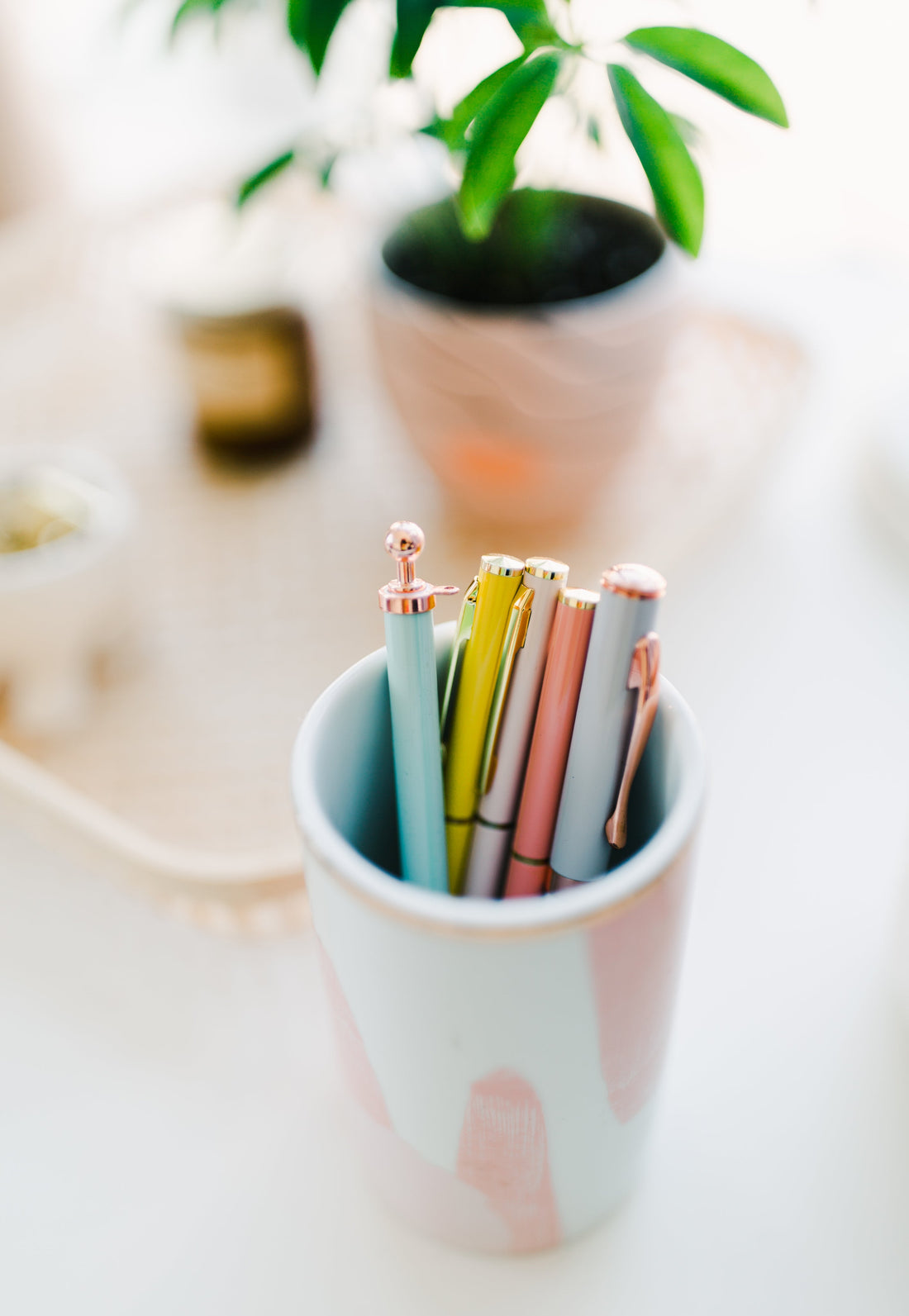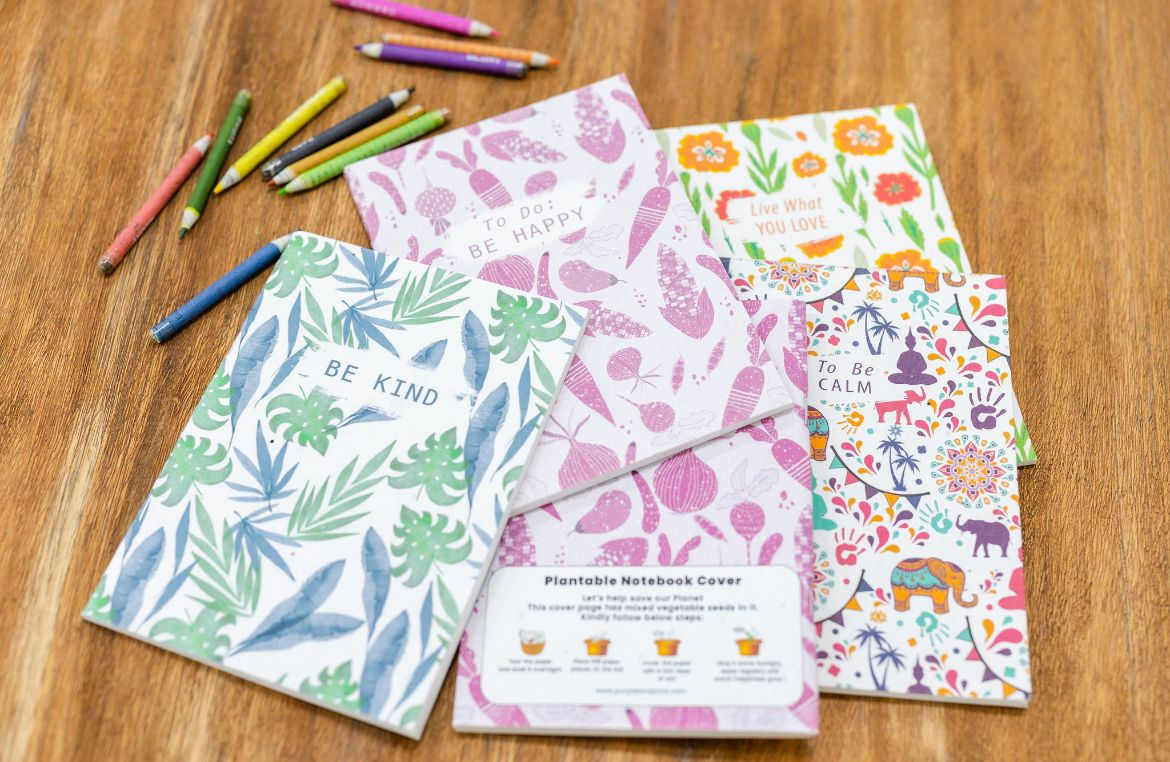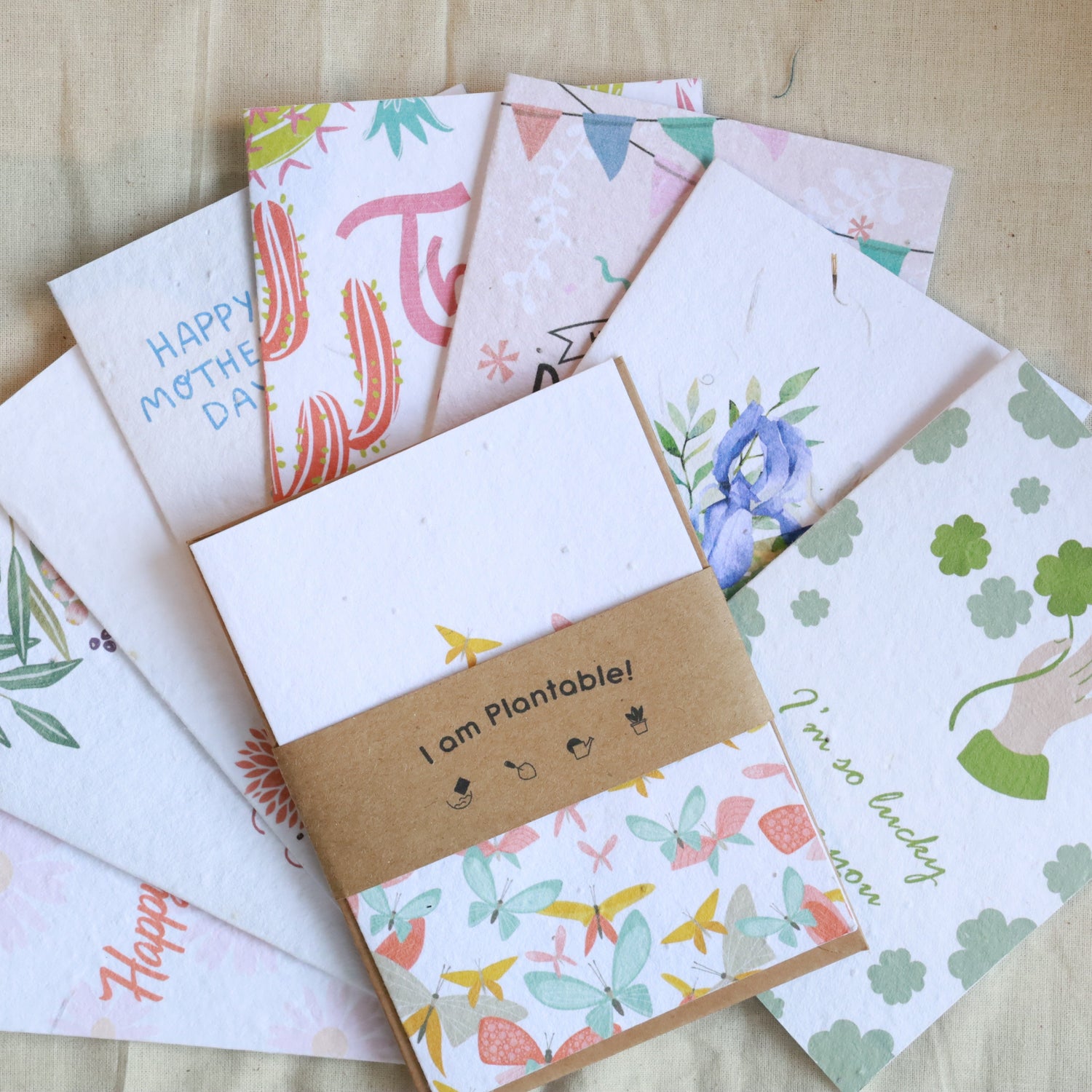
Green Thumb Guide: How to Grow Your Own Plantable Stationery
Share
In today's eco-conscious world, the demand for sustainable and eco-friendly products is on the rise. One such innovative concept gaining popularity is plantable stationery. Let's delve into what plantable stationery is, its types, benefits, and how you can make the switch to this environmentally friendly alternative.
What is Plantable Stationery?
Plantable stationery is a unique and sustainable alternative to traditional paper products. It is made from recycled materials embedded with seeds, allowing users to plant the stationery once it's no longer needed and watch it grow into plants.
Types of Plantable Stationery:
- Plantable Notebooks: 100% of the recycled paper of the notebook is made from seed paper. Once you've filled the pages, you can plant the notebook to grow herbs or vegetables. The plantable seed notebook is a popular choice, featuring different seeds of your choice.
- Plantable Pens: The pen is made from recycled paper and has a regular ballpoint refill, so it works just like any other pen. Plus, each pen has a seed inside it! Purple and Pure's pen sets come with seeds of coriander, brinjal, mustard, basil, and tomato.
- Plantable Calendars: These calendars are made from recycled paper embedded with seeds. Once the year is over, simply plant the calendar to grow plants.
- Plantable Business Cards: Made from seed paper, these business cards can be planted to grow into plants after use. Purple and Pure offers Plantable Business Cards with seeds of marigolds, basil, mixed vegetables, and wildflowers.
Different Veggies and Flower Seeds Offered by Purple & Pure:
- Basil: Bursting with aromatic flavour, basil not only enhances the taste of your dishes but also contains antioxidants that support overall health.
- Marigold: Besides adding a pop of colour to your garden, marigolds attract beneficial insects like bees and butterflies, promoting pollination and biodiversity.
- Brinjal: Rich in fibre and nutrients, brinjal offers versatility in cooking styles and provides essential vitamins for a balanced diet.
- Coriander: With its refreshing aroma and distinct taste, coriander not only adds flavour to your meals but also aids digestion and helps regulate blood sugar levels.
- Fenugreek: Known for its slightly bitter taste, fenugreek seeds are packed with fibre and can support digestion and heart health when consumed regularly.
- Tomato: Juicy and flavorful, tomatoes are not only delicious but also rich in vitamins, minerals, and antioxidants that promote skin and heart health.
- Mustard: Offering a tangy and spicy kick, mustard seeds contain essential nutrients like magnesium and selenium, supporting bone health and immune function.
- Green Chilli: Adding heat and intensity to dishes, green chillies contain capsaicin, which can boost metabolism and promote weight loss.
- Capsicum: Sweet and crunchy, capsicum is a rich source of vitamin C, which supports immunity and collagen production for healthy skin.
Out of The Box Planting Techniques for Plant Parents:

Plantable Notebooks
There are multiple tips on the internet which are available, but here is a compilation of the different plantable techniques plant parents can use:
- Ice cube watering: For precise watering, place ice cubes at the base of plants. As the ice melts, it releases water slowly, preventing overwatering and ensuring roots receive moisture gradually.
- Banana peel fertiliser: Boost soil fertility by burying banana peels around plants. As the peels decompose, they release nutrients like potassium, phosphorus, and calcium, enriching the soil and promoting healthy growth.
- Eggshell seed starters: Start seeds in emptied eggshells filled with soil. The shells provide nutrients like calcium and act as natural seed starters, allowing seedlings to grow strong roots before transplanting into larger pots or garden beds.
-
Potato potting: Repurpose potato sacks or bags as planters for growing potatoes. Simply fill the bags with soil and plant potato tubers. As the plants grow, add more soil, and harvest fresh potatoes from the bag when ready.
- Coffee ground compost: Use coffee grounds as compost to enrich soil and add acidity. Mix used coffee grounds into compost piles or directly into garden beds to improve soil structure, retain moisture, and deter pests.
- Tea Bag planters: Start seeds in biodegradable tea bags filled with soil. Once seedlings emerge, plant the entire tea bag directly into the ground or a larger pot, allowing it to decompose and nourish the growing plant.
- Wine cork drainage: Improve drainage in potted plants by placing wine corks at the bottom of pots before adding soil. The corks create air pockets, preventing waterlogging and promoting healthier root growth.
- Citrus peel seedlings: Start seeds in hollowed-out citrus peels filled with soil. The peels provide moisture and nutrients, while their acidity discourages pests and fungal growth. Once seedlings outgrow the peels, transplant them into larger containers or garden beds.
- Pine cone mulch: Use pine cones as natural mulch to suppress weeds and retain moisture in garden beds. Scatter pine cones around plants to create a decorative and functional mulch layer that also adds texture to the garden.
- Newspaper pots: Create biodegradable seedling pots using rolled-up newspaper. Fill the pots with soil, plant seeds, and once seedlings are ready for transplanting, place the entire newspaper pot directly into the ground, where it will break down over time.
How to Use and Maintain Plantable Stationery:
Plantable-Pens
- Use As You Would Regular Stationery:
Use plantable stationery like you would any other paper product for writing, drawing, or note-taking. Enjoy the same functionality and convenience while knowing that you're using an eco-friendly alternative that supports sustainability.
- Plant in Soil Once No Longer Needed:
Once you've finished using your plantable stationery like plantable notebooks, tear it into small pieces and plant them in soil. Choose a sunny spot in your garden or a pot, bury the paper scraps, and cover them lightly with soil.
- Water Regularly and Watch Your Plants Grow:
Water the planted paper scraps regularly, keeping the soil moist but not waterlogged. With proper care and sunlight, you'll soon see your paper scraps sprout into beautiful plants, adding a touch of greenery to your surroundings.
- Provide Adequate Sunlight:
Place the planted paper scraps in an area where they can receive plenty of sunlight, as most plants require sunlight for photosynthesis and growth. Choose a location with at least 4-6 hours of direct sunlight each day to ensure optimal plant growth.
- Monitor Soil Moisture:
Check the soil moisture regularly by gently touching the soil surface with your finger. Water the planted paper scraps whenever the soil feels dry to the touch, ensuring that the growing plants have a consistent water supply for healthy development.
- Trim and Prune as Needed:
Once your plants begin to grow, trim or prune them as needed to promote healthy growth and prevent overcrowding. Remove any yellowing or damaged leaves, and trim back overgrown branches to encourage bushier growth and enhance the overall appearance of your plantable stationery garden.
Making the Switch to Plantable Stationery:
Plantable Pencil
- Educate Yourself: Learn about the benefits of plantable stationery and its environmental impact
- Start Small: Begin by incorporating one or two plantable products into your stationery collection.
- Spread the Word: Share your experience with friends and family to encourage them to make the switch too.
- Support Eco-Friendly Brands: Choose brands that prioritise sustainability and offer plantable stationery options.
Conclusion
Plantable stationery such as plantable pens or bookmarks offers a sustainable and eco-friendly alternative to traditional paper products. By incorporating plantable stationery into your daily life, you can reduce waste, promote sustainability, and enjoy the beauty of growing your own plants. So why not make the switch today and join the green revolution?

